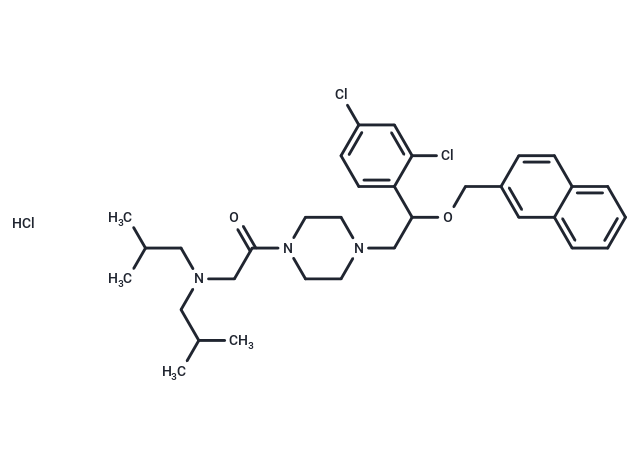Shopping Cart
- Remove All
 Your shopping cart is currently empty
Your shopping cart is currently empty

LYN-1604 hydrochloride, a powerful activator of UNC-51-like kinase 1 (ULK1) with an EC50 value of 18.94 nM, has significant implications in the study of triple-negative breast cancer (TNBC).

| Pack Size | Price | Availability | Quantity |
|---|---|---|---|
| 50 mg | $1,152 | 1-2 weeks | |
| 100 mg | $2,117 | 1-2 weeks |
| Description | LYN-1604 hydrochloride, a powerful activator of UNC-51-like kinase 1 (ULK1) with an EC50 value of 18.94 nM, has significant implications in the study of triple-negative breast cancer (TNBC). |
| Targets&IC50 | ULK1:18.94 nM (EC50) |
| In vitro | LYN-1604, identified as a potential ULK1 agonist, demonstrates enhanced enzymatic activity (195.7% at 100 nM) and exhibits a half-maximal inhibitory concentration (IC50) of 1.66 μM against MDA-MB-231 cells. It binds to the wild-type ULK1 with a nanomolar affinity (KD = 291.4 nM). At varying concentrations (0.5, 1.0, and 2.0 μM), LYN-1604 triggers cell death through the ULK complex in MDA-MB-231 cells and induces dose-dependent autophagy, evidenced by a notable increase in Beclin-1 expression, p62 degradation, and conversion of LC3-I to LC3-II. Additionally, it promotes ATG5-dependent autophagy via the ULK complex and facilitates apoptosis through increased caspase-3 cleavage. Cell viability assays and Western blot analyses further confirm these effects, showing dose-dependent induced cell death and autophagy, alongside the up-regulation of Beclin-1, degradation of p62, and LC3-I to LC3-II transformation, after a 24-hour incubation with LYN-1604. |
| In vivo | LYN-1604, administered intragastrically at various doses (low dose, 25 mg/kg; median dose, 50 mg/kg; high dose, 100 mg/kg) once daily for 14 days, significantly inhibits the growth of xenograft triple-negative breast cancer (TNBC) by targeting ULK1-modulated cell death, as demonstrated in an animal model using 24 female nude mice (BALB/c, 6-8 weeks, 20-22 g). The study reports no change in the body weights of mice across all doses, indicating a lack of systemic toxicity. However, a slight increase in liver and spleen weight indexes was observed in some groups, while the kidney weight index remained unaffected across all dose groups. |
| Molecular Weight | 621.08 |
| Formula | C33H44Cl3N3O2 |
| Cas No. | 2216753-86-3 |
| Relative Density. | no data available |
| Storage | Powder: -20°C for 3 years | In solvent: -80°C for 1 year | Shipping with blue ice. |

Copyright © 2015-2025 TargetMol Chemicals Inc. All Rights Reserved.